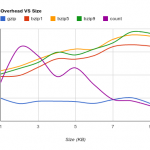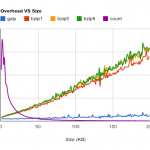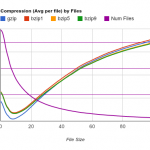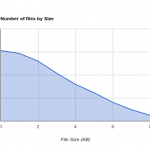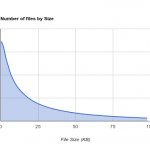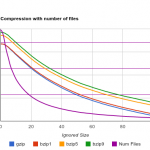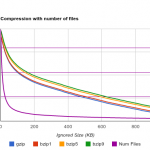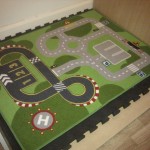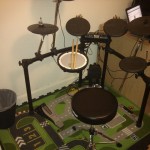Yesterday was The Marathon. A year of working towards it, with all the training and pain that goes with it. Coupled with picking up the flu (not man flu, but real flu, the kind that takes four weeks to clear properly) and my knee giving out a few weeks back, it was a day that really could have gone either way. But here we are.
A Giant Thank You!
I don’t think I said enough when thanking everyone for the previous run events. Given this was my first marathon, maybe I’m being overly generous, but the only thing I can fault the organisers on is the lack of jellies in my goodie bag at the end. Like come on, they were there for every other event.
In all seriousness, the event was fantastically run. I’ve taken part in some large scale events in the past with thousands of participants, but this is a different scale due to the shorter distance. Everything was very well laid out and there were crowds and people lining the streets all along the route. I really don’t remember many sections without people, and usually these were directly after the Spar Cheering Zones. Big up to Spar too. You could tell a cheering zone was coming up well in advance. Large crowds cheering and guys beating the drums, and of course the dancing Spar red thing. I can only assume that Spar played a part in getting some of the sweets around the course as well. While I didn’t take any, just having people standing with them, supporting, it does help push you onwards.
To the supporters, thank you. While not there for me directly, you were supporting the event and adding to the atmosphere. Even to you kid who made fun of my jogging pace just before the turn at the UCD flyover, thank you. That level of support is really something missing for most of the cycling events, partly due to the distances being orders of magnitude longer, although the Tour of Meath does manage to continually have the best atmosphere.
Race Day minus 4 weeks
Why am I starting here? Well as I alluded above, my problems started about 6 weeks before the marathon. During one of my LSRs, I pretty much fell apart. My knee gave out just before the half way point resulting in a near death march home. And given the route was an out and back style route, the shortest way home was the route. A day or two after I ended up with the flu which knocked me right off my feet. Sick enough that I took my first sick day from work in a long time. Long enough that I can’t remember the last sick day I took.
It was a whole week before I got out to do any exercise again, a 14km run at a whooping 6:22min/km, and I was like the walking dead afterwards. The runs did pick up a little the following week but I was still a mess and mostly struggling.
Race Day minus 5 days
Being somewhat smart I decided to take time off work around the marathon, although admittedly was more to use the days I had than anything else. But it didn’t start well. Even before finishing up in work I had stomach pain. Since I’m no stranger to stomach pain, I really didn’t pay much attention to it until later that night. It didn’t let up and just continued to get worse, right up to the point where standing up straight was difficult. Eventually by close to 1am it had let up enough that I could get some sleep. Let up, but not gone away.
The pain continued into the next day and led to constipation of sorts. Needless to say, my mindset changed to one of wondering if I’d actually make it to the start line, let alone finish.
Race Day
With the big day upon me, I was incredibly lucky that my stomach had decided to settle somewhat. All systems were go as they say and it was onward into town for 8am.
If I was running the marathon and had an unlimited amount of money, one thing I’d change is a heated start area. Few giant heaters warming the air while standing around. I’m sure Tony Stark could invent something eco friendly too.
3, 2, 1 and they are off
As the hour inched forward I eventually dispensed with my base layer, dropped the bag off, and started on the way around to my pen. 3:45 – 4:15 finish time, which on normal day would be perfect. 5:30min/km is my safe fallback speed that I seem to end up if I slow down. On a good day it’d be open roads due to the minute gap to the front group. I even managed to get into the pen maybe 5 metres back from the start, although somehow huge numbers ended up ahead by the real start line. Still it wasn’t overly congested and I was jogging along pretty quickly.
The cold played a huge part. For the first time in a long time, km1 came and went and I wasn’t warmed up. km 2 too, followed by km 3 and 4. Even at 6km in I was still feeling the cold. Unusual to say the least and I’ll partly put it down to getting so cold at the start. Yes I wore an extra top to keep some heat while standing around, but it was quite cold.
And here comes the midway point
Skipping ahead perhaps, but once I warmed up things became uneventful. Exactly what you want in a marathon. Just plodding along. I was holding a nice solid pace near 5min/km, a bit higher than previous runs, but overall I was happy with it given my last few weeks.
This is when the problems began. Going into the event, I really wasn’t sure how I’d hold up liquid wise. I’d taken to running with a bottle of sports drink and it it was working pretty well. I somehow go confused while running thinking that there was a sportdrink stop at 15 miles, confusing the original map since it had miles. I’m not sure why, but I ran through the one before the half way point without picking up a bottle, presumably since I had some still left in mine. When it ran out around around 19km, I began to realise my mistake. It didn’t dawn on my until the halfway banner came and went, then followed by mile 14.
By the time the water stop came at mile 15, the damage was done. My pace has really dropped off and my knee was starting to hurt quite a bit. Muscles in my hamstrings and calves followed, I’d say shortly, but then everything in a marathon seems longer while you are experiencing it.
18.5, a magic number
Why a magic number? Some Spar Sport drink, that is why.
The graphs don’t tell the full story, but I most definitely started to improve from then on, at least subjectively. Ok my speed went down, but I wasn’t feeling like a zombie anymore and the marathon switched to a purely mental exercise. One I knew I could win. Words from a friend a few day prior were rattling around in my head pushing me on.
I've known you long enough to know that no matter how bad you feel,
in events like this, you are indestructible.
How could I give up with words like that?
There goes the wall, what wall?
I guess anyone who has talked about marathons has heard of this mythical wall. The point when your body runs out energy and it feels like you’ve just had an elephant dropped on your shoulders. I had always thought of the wall as similar to bonking in cycling, where you run out of energy from not eating and drinking enough. Cycling is definitely different to running in that events are longer time wise, and pretty much impossible without eating on the go. The body just doesn’t enough energy reserves for eight and half hours of non-stop, near the limit physical activity, without some refuelling.
There still reaches a point that you muscles raise the white flag and say enough is enough, so perhaps that is a better analogue to the runners wall. Given I’d experienced this too back shortly after I took up cycling, I knew just how bad it could get, and with the UCD flyover being at mile 22, the hill was perfectly posed to mark the wall, maybe being a hill too far?
Yet nothing. It came and went without much impact. Ok I was going slower than just about everyone on the road around me, but I had been since I slowed after the half way point. Maybe the wall comes later for some?
Spots, red spots, oh…
One thing I used to suffer from is nose bleeds. Few times I’d wake up in the night with one, although mostly I’d get that feeling that as soon as I blew my nose, it’d be a nose bleed. This last year hadn’t resulted in one, until now. 24 miles into a marathon.

Those aren’t dirt marks on the number. Lucky it wasn’t as bad as some previous ones and stopped quick enough. I can only assume it was caused by blowing my nose so often from having the tail end of the flu.
The worst part was covering my face anytime I saw a yellow jacket. St. John Ambulance were everywhere near the end and I really didn’t want them to try pulling me for the nose bleed. (An aside, those guys are great. Luckily I’ve never had to part-take of their services, but I know of more than one person who owes their life to them from other events.)
Here comes the noise
With Dublin City Centre getting closer foot step by foot step, the roads got more and more familiar. All along from before UCD when the 3:45 pace group passed me, I had started trying to do the maths to see just how much time I could lose and still get home in time. Needless to say, my brain wasn’t working all too well.
When we came to the back of Trinity and my average had only dropped to 5:31, I began to think that yes, yes I can do this. My defining memory is switching my GPS to the screen with the overall time and it reading 3:47. At that point it hit home, that yes, short of something completely catastrophic, I was going to make it under the 4hr mark. The elephant disappeared and running became almost easy again. Knowing that even at a near walking pace I’d make it, I didn’t push, but just continued, smiling along as much as I do.
Enter the Green Zone
That last 500 meters really is the longest 500 meters you’ll ever run. You know the finish is just ahead. You can hear the crowds. You can hear the announcer calling out as people cross over. But you can’t see it as it is just behind that building.
And then you see it. The banners. The mats. The boxes. The clocks. Time slows down for those last few steps.
I remember crossing the line and slowing to a walking pace, raising my arms and just feeling amazing. I’d done it. First and only marathon over. Yes it had been painful and the training had fallen apart at the end, but I’d made my medium goal time. I also remember my name being called out by the announcer, something which makes you feel surprisingly special, even though you know you are just another anon in a sea of anons.
The hard figures
My official time was 3:56:34 with a chip time of 3:56:06. I was a little worried that if they used the first wave start time, I wouldn’t have made it under 4 hours as I went along at Trinity, by I knew no amount of speed would have gotten me around in 3 minutes. Overall position of 5050 and a category position of 1544. Not as high as some of the previous runs, but definitely respectable.
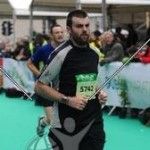
I do wish I took a better picture too.
An aftermath
Well I had said long before this marathon that this was my first and only marathon. And short of getting a shot at the New York Marathon, that is true. I might run some of the shorter events, but I can’t see myself going through the marathon again. Running just isn’t all that much fun. Best described as hitting yourself with a hammer for 4 hours. Yes there are some huge upsides to the running events, but they don’t really counter act the fact that running is quite boring.
Like most others, I have felt quite stiff afterwards. My legs didn’t feel too bad the day of the marathon although my feet were, especially my big toes. The day after was a different story with the muscles being tight and painful that even made it difficult to sleep. Today has been solely determined by knee and its pain of sorts. Mainly its funny bone style pain resulting in a weakness that makes it hard to stand. And this is likely to be the defining factor for the future months.
I’ll hopefully see Mr Knee Doctor Specialist next week to get a proper opinion, but my knee problems have gone on long enough that I need to go back and find a better solution. I someone how doubt that running for cross training to build up other stabilising muscles will work this time around.
In Closing
I must apologise for the rambling nature of the post. The marathon really was the result of years goal and I know I’ll look back on it, presumably fondly due to the lovely nature of the human memory. 100% I’m glad I took to the start and finish the marathon. It has been something I’ve wanted to do for as long as I can remember.
If you were to do a marathon, then the Dublin Marathon is definitely a good candidate, just remember to train.
